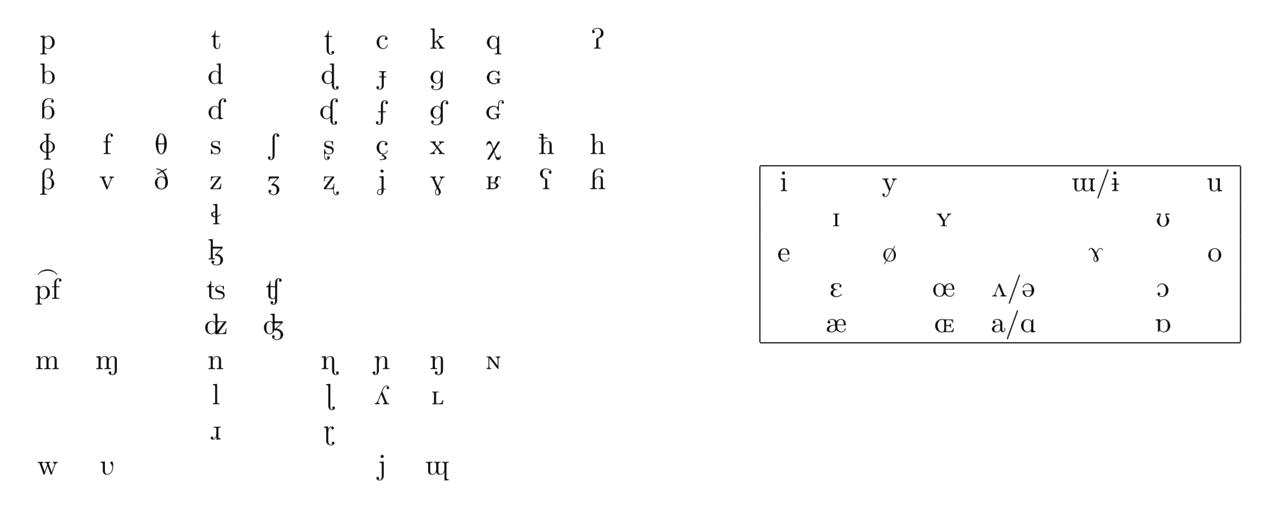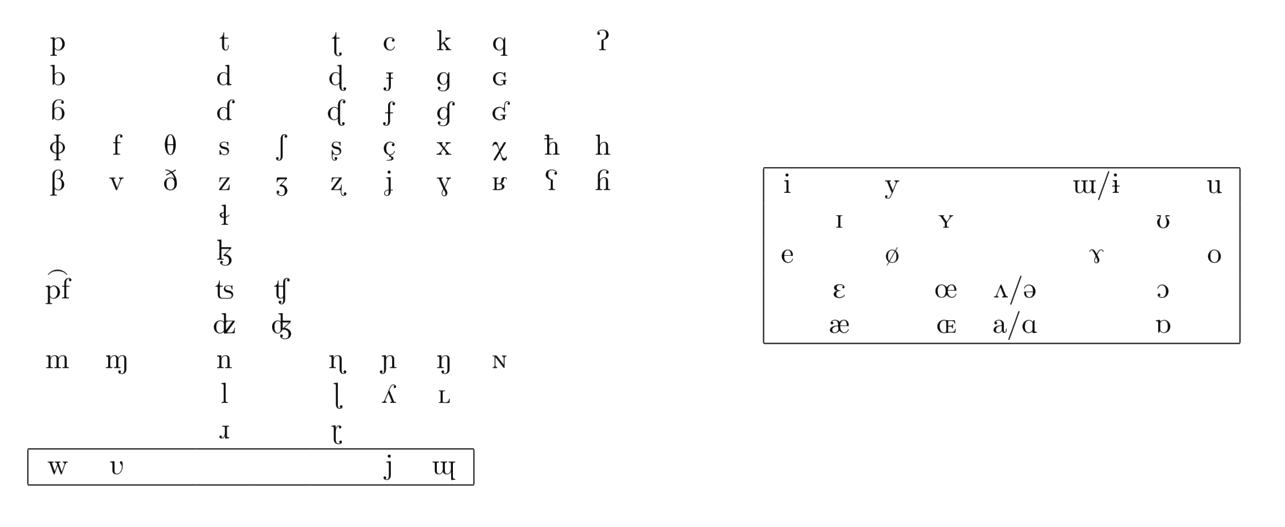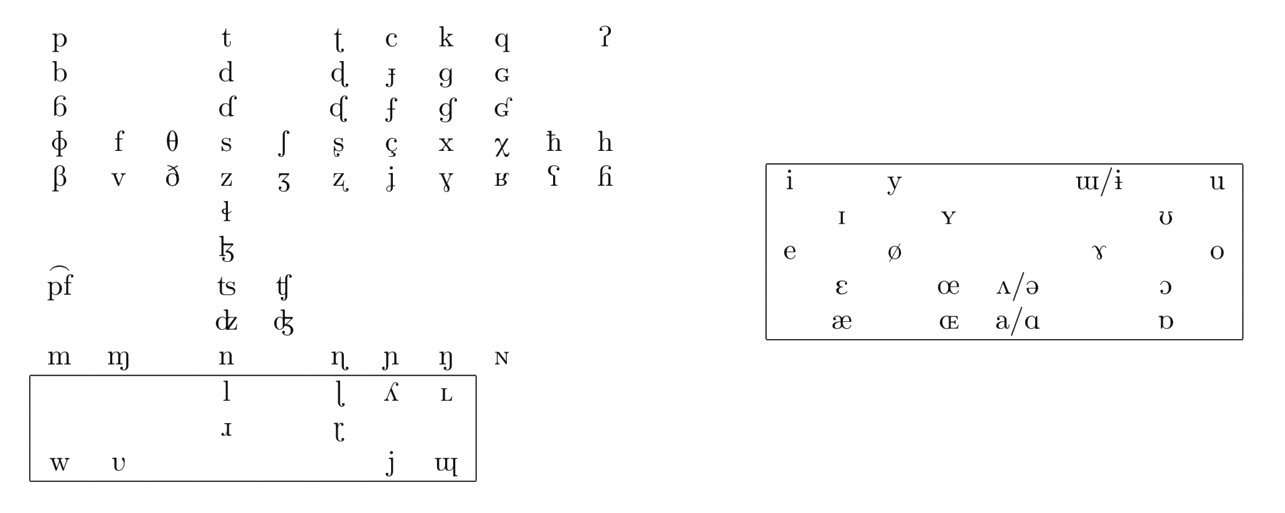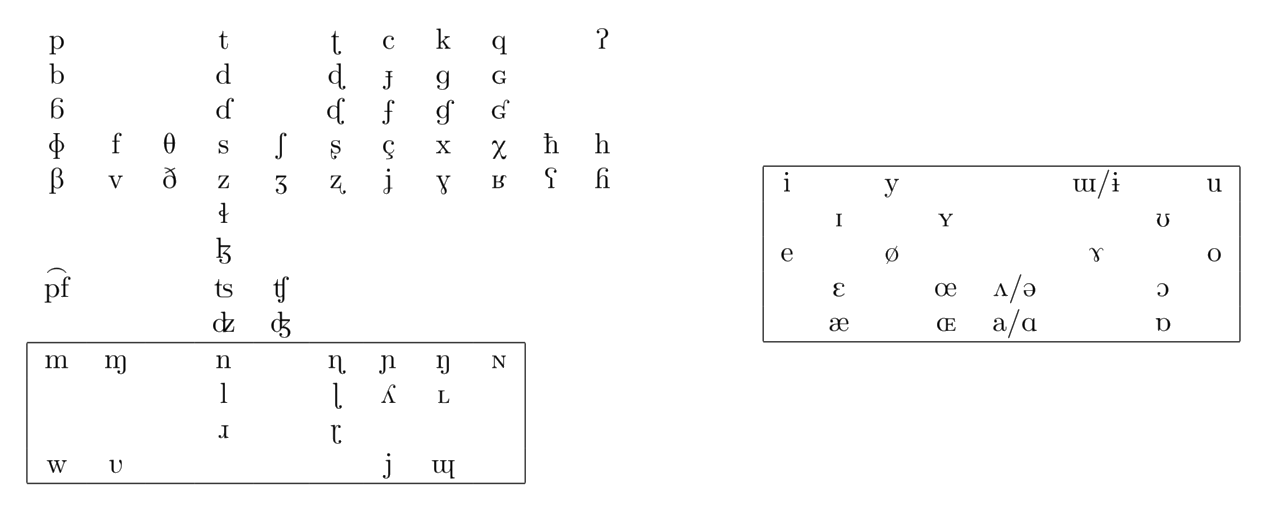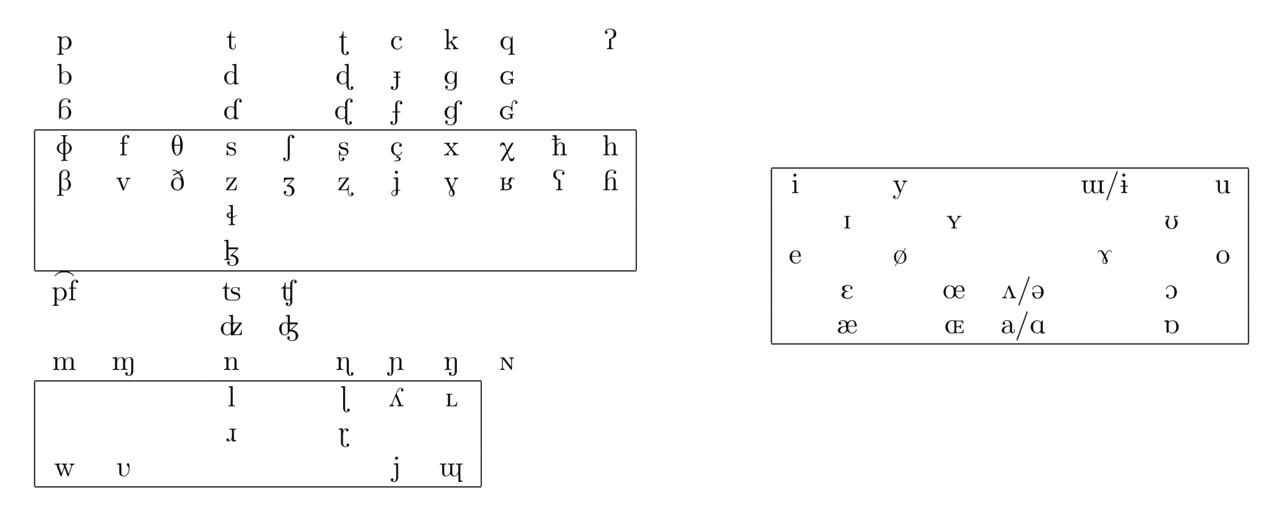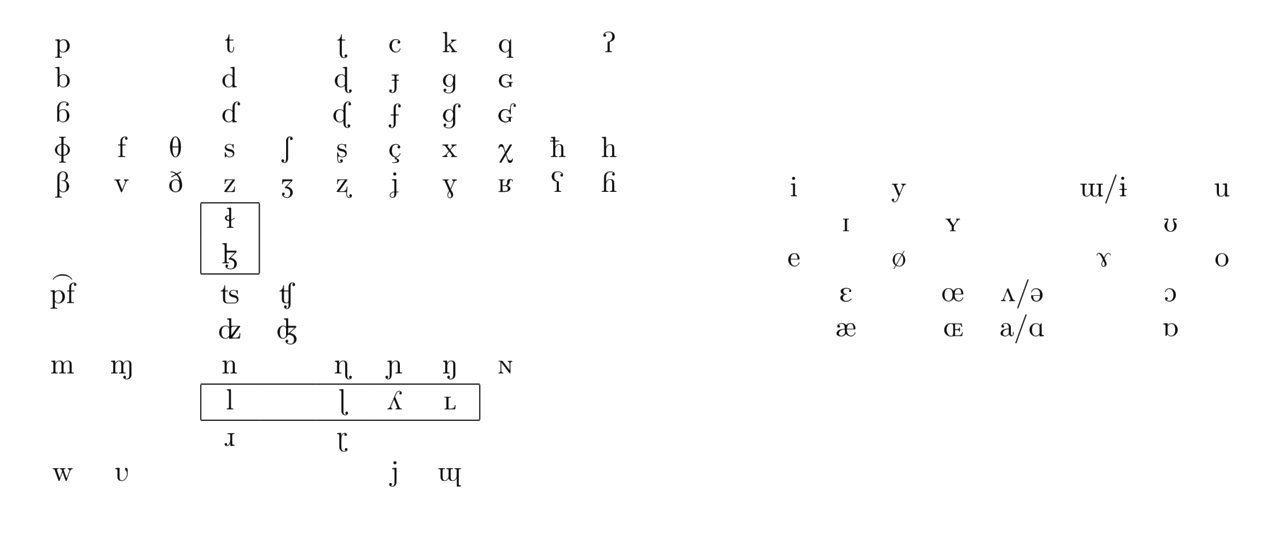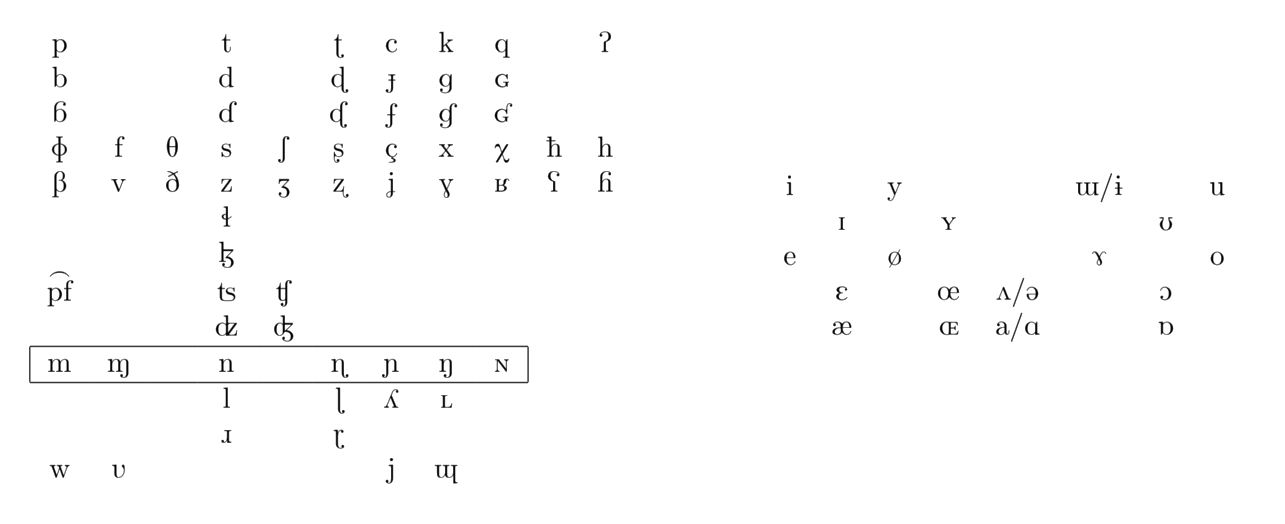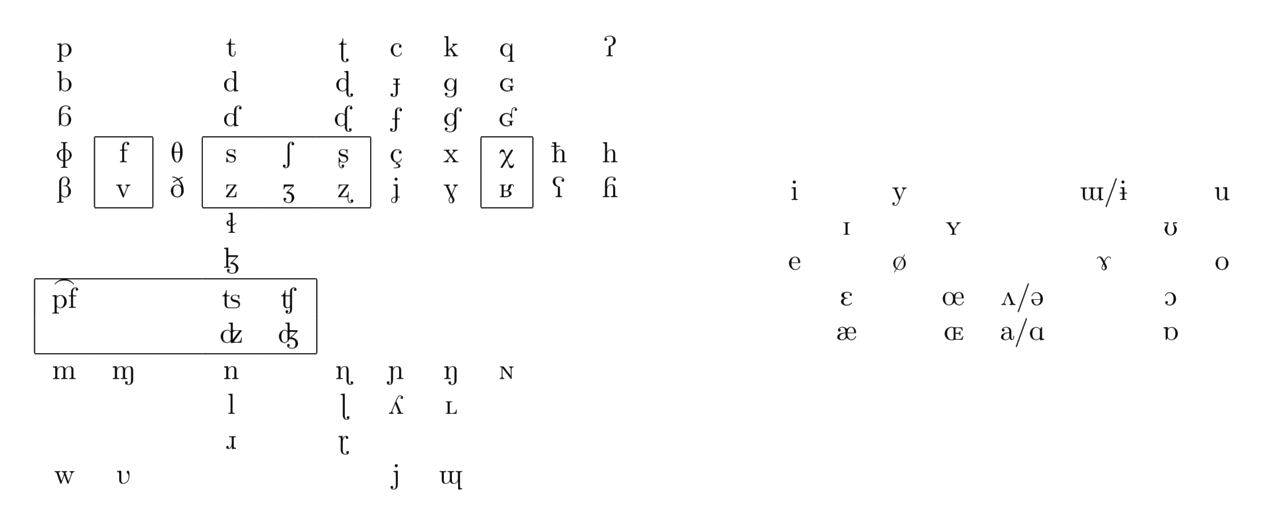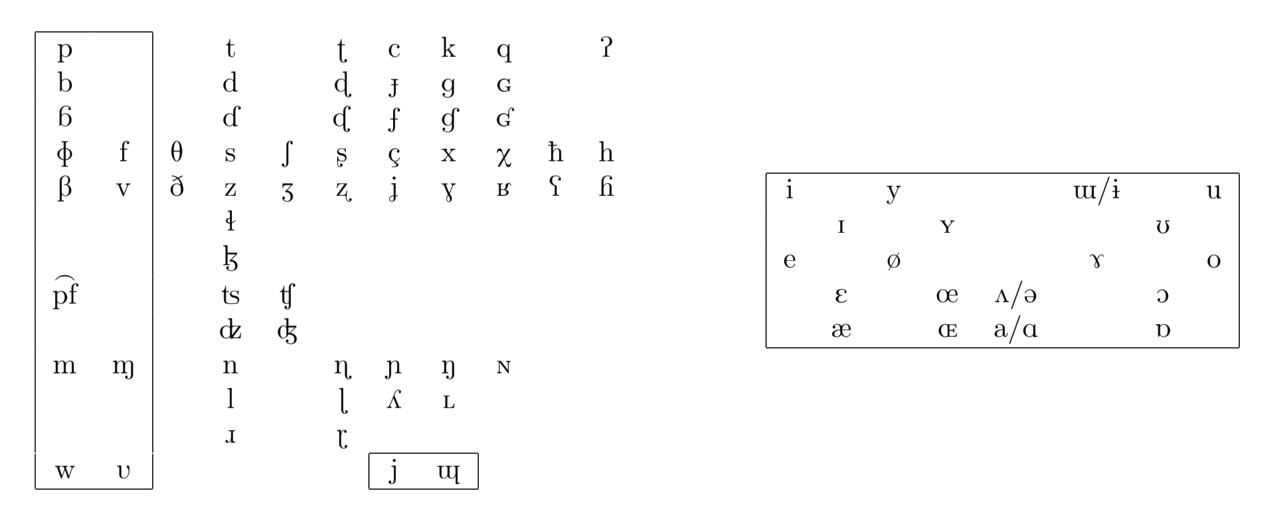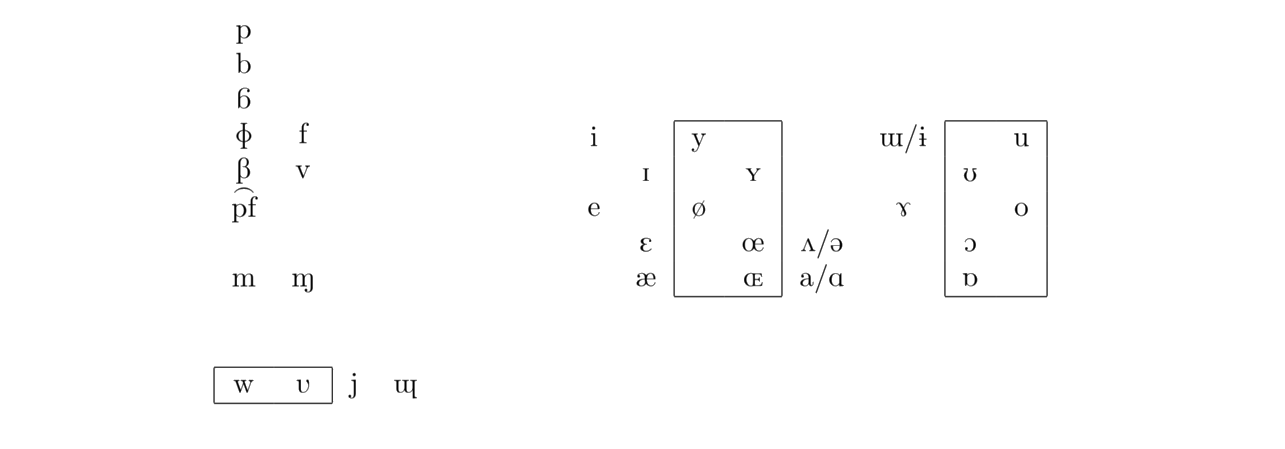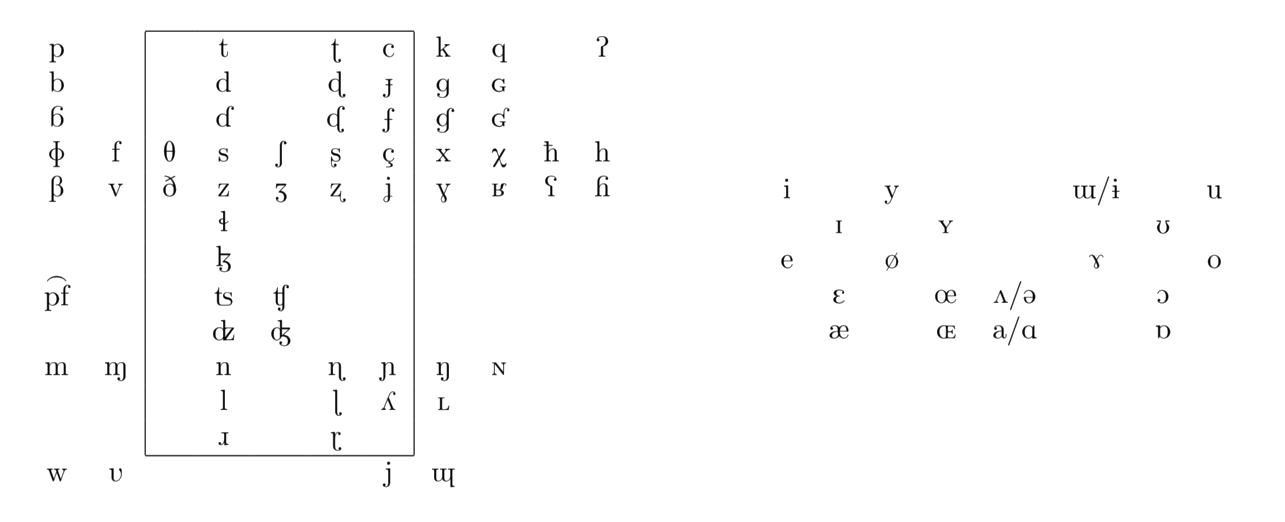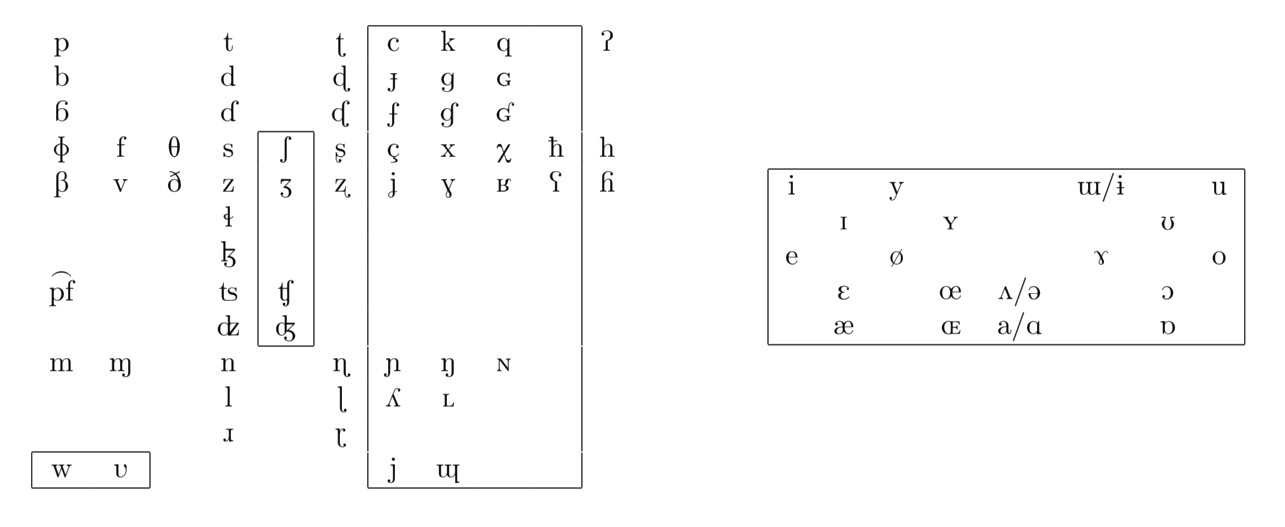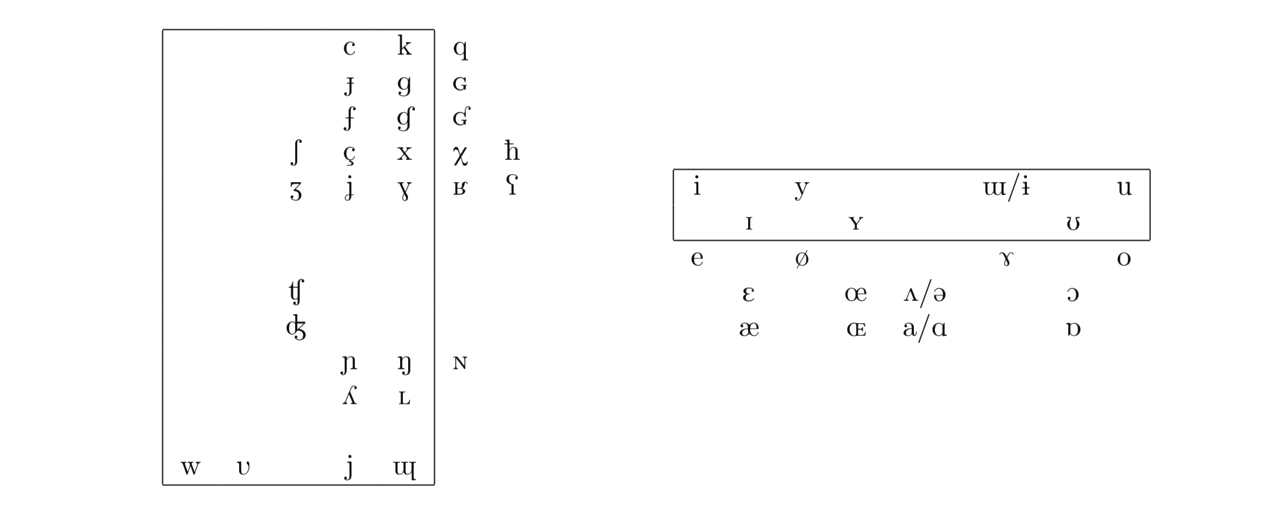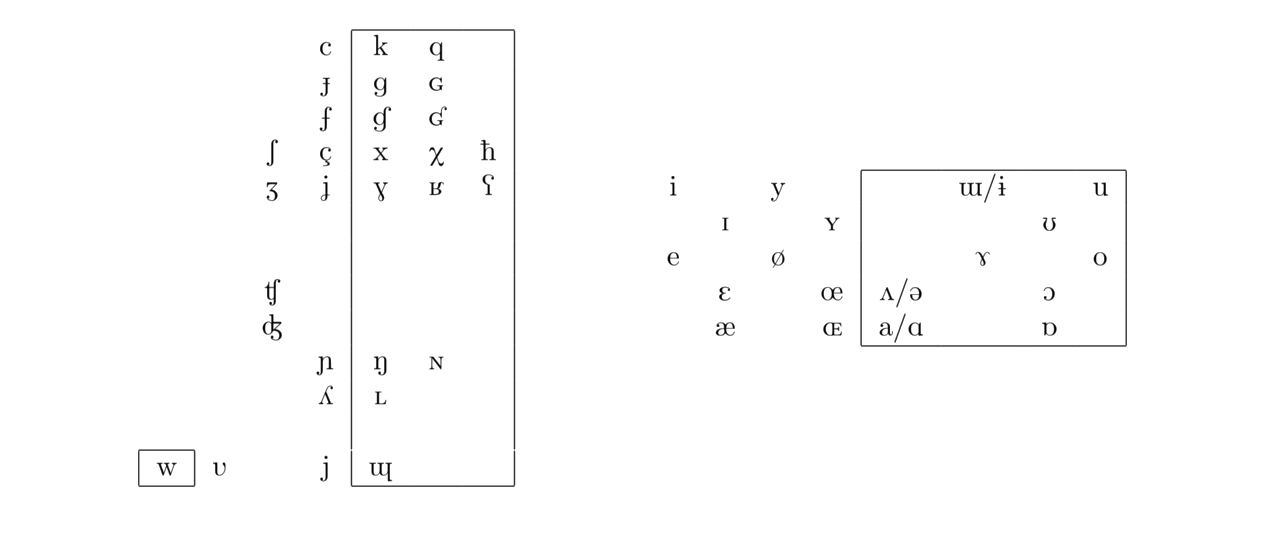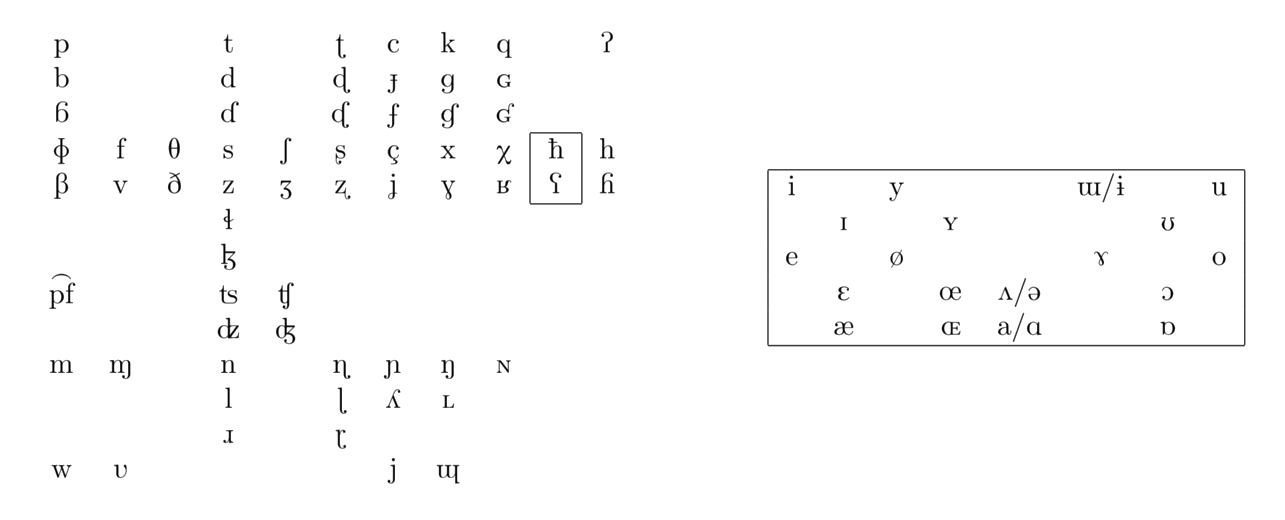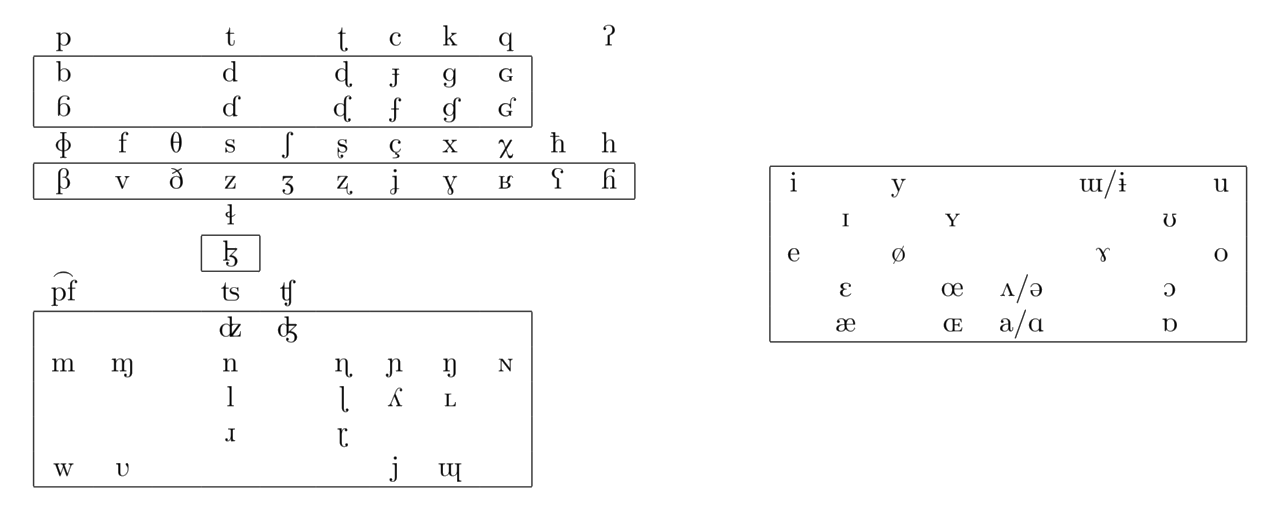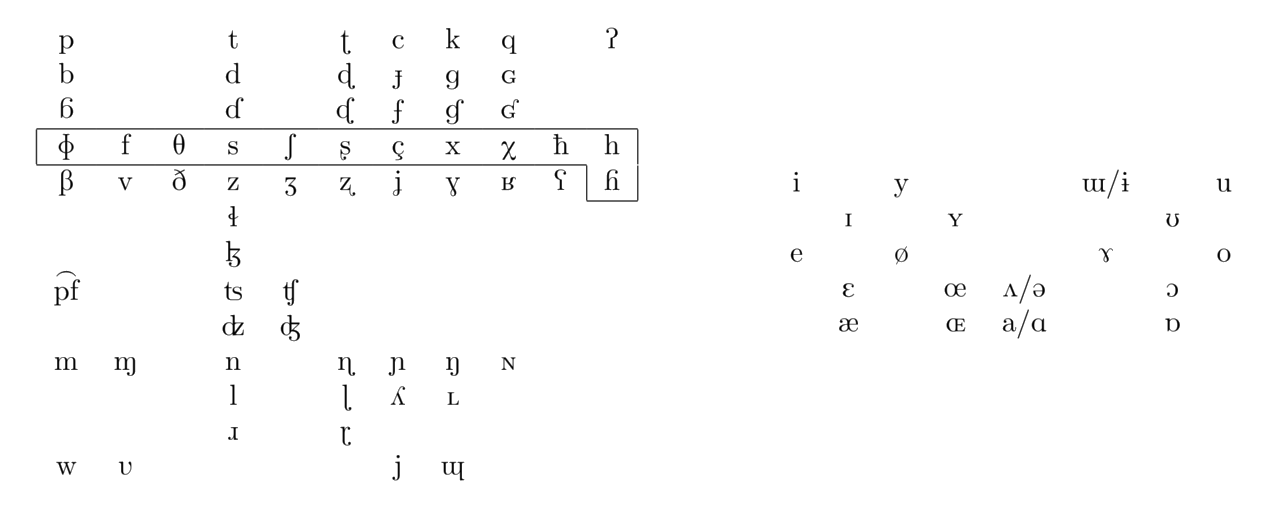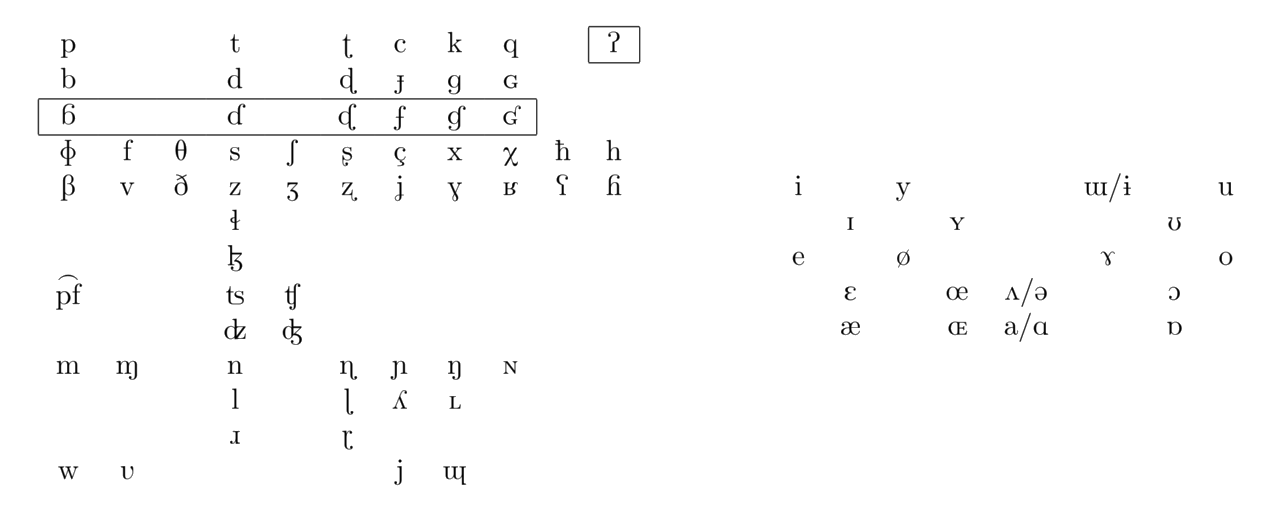Introduction to Phonology, Part 3: Phonetic Features
In the previous post, I covered most of the basics of phonetics concerning how we can describe speech sounds, or “phones”. Specifically, I talked about two sets of aspects (one for vowels and one for consonants), and how some of these can be subdivided. Next, I’ll talk a little more about these subdivisions (and some more than I left out last time).
It’s a little messy to deal with separate features for vowels and consonants, so instead we consider that all features can apply to any sound, and that each feature has a specification of either positive or negative. For the purposes of this post, we will assume that all sounds have specifications for all features.
The full feature list can be divided into four broad groups: major class features, manner features, place features, and laryngeal features. I will discuss the groups in broad terms, and then I will go into a bit more depth with each feature. For each feature, I will provide a listing of the phones that are considered to have a positive specification for that feature. These listings are images taken from this document about the phonological features (PDF), which was provided to students in my phonology class taught by Dr. Aaron Kaplan at the University of Utah, though I do not know if he wrote it himself.
How to discuss features
I mentioned above that phones can be specified in terms of positive and negative values for all features. When we write about a sound’s features (or about how a feature relates to a sound), we write the feature in brackets with a + or - to indicate its value. For example, the voiced velar stop [g] is [+voiced], [+dorsal], [+high], among other things.
When a phone has multiple feature specifications that we are interested in talking about, we produce a feature matrix. [g] could be [+voiced, +dorsal, +high]. (Often, in literature, these are written in a vertical fashion with the brackets extending the length of the stack, but for brevity’s sake I will stick to in-line matrices.)
Additionally, all features have a shorthand name. [g] is [+voi, +dor, +hi]. This is done simply to save space. I will provide the shorthand names for all features in this post, though I will stick to the full names for my discussion.
Major class features
There are four major class features:
- syllabic
- vocalic
- approximant
- sonorant
(The document I linked above lists 8, but I have separated the manner features from these.)
These four features don’t have much in common physically, but they guide the overall “type” of a phone.
[syllabic] / [syl]
[+syllabic] sounds are those which may function as the nucleus of a syllable. I will avoid an in-depth discussion of prosody (syllables ‘n’ stuff) for now, but the basic gist is that these sounds can be the “center” of a syllable. By default, only vowels are [+syllabic], and all consonants are [-syllabic].
However, sometimes certain consonants can become [+syllabic]. In English, we sometimes find [ɹ] (the “r” sound in “her” and “red”) becomes syllabic. For example, consider the word “fire”. Some people pronounce this as a single syllable, but I pronounce it as two: [‘faɪ.ɹ] (where the . in the middle denotes the separation of two syllables, and the leading single-quote ‘ precedes the stressed syllable). However, when dealing with some languages (such as English) this is often instead transcribed into IPA as [‘faɪ.əɹ].
[vocalic] / [voc]
The vowels and glides (or “semi-vowels”) are considered [+vocalic], and all other sounds are [-vocalic]. This feature exists primarily to distinguish the glides from other consonants due to their similarity to vowels. (Glides are essentially just vowels that want to be consonants.)
[approximant] / [approx]
[+approximant] phones are a superset of the [+vocalic] phones. [+approximant] applies to all of the approximants, which includes vowels, liquids (e.g. [l], [r], [ɹ]), and glides (e.g. [w], [j]). All other sounds are [-approximant].
[sonorant] / [son]
[+sonorant] are another superset, this time of the [+approximant] phones. [+sonorant] additionally includes nasal consonants. (Specifically, “sonorant” refers to any speech sound which produces a non-turbulent airflow.)
Manner features
There are also four manner features:
- continuant
- lateral
- nasal
- strident
These features are used to describe how the articulators are used to modify the airflow as it comes out from the lungs. The combination of these four binary manner features produces the seven manners of articulation that I detailed in the previous post.
[continuant] / [cont]
The phones which are [+continuant] involve a partial occlusion of the airway, meaning your mouth might be mostly closed or your tongue may be blocking the airflow, or a few other things. Air must flow over a period of time; that is, the airflow is continuous. All vowels, glides, liquids, and fricatives are [+continuant]. Stops, affricates, and nasals are [-continuant]. Data are inconclusive for laterals, taps/flaps, or trills.
[lateral] / [lat]
The [+lateral] sounds are those which involve air flowing around the sides of the tongue (instead of over the top of it). The lateral approximants and fricatives are [+lateral], and other sounds are [-lateral]. (There are also lateral clicks which appear only in African languages, but these are not detailed in the charts on this page because I am only discussing sounds with a pulmonic egressive airflow.)
[nasal] / [nas]
[+nasal] sounds allow air to escape through the nasal cavity (nose). Most sounds are [-nasal], but the stops indicated above are all [+nasal].
[strident] / [stri]
Sounds which are [+strident] are characterized by high-frequency noise. All affricates are [+strident], and fricatives at the following places of articulation are also [+strident]: labiodental, alveolar, palato-alveolar, retroflex, and uvular. All other sounds are [-strident].
Place features
There are eleven total place features (including the dependent features). Place features describe where in the mouth the primary articular is positioned to produce a particular sound. The place features are:
- labial
- round
- coronal
- anterior
- distributed
- dorsal
- high
- low
- back
- pharyngeal
- ATR
The indentation of certain features indicates dependent features. A dependent feature, such as round, can only be given a specification if its parent feature has a positive specification. So a sound which has a [-labial] specification cannot be [+round] or [-round]. “Well that seems weirdly selective,” you might say — and you’d be right! But that’s the way it goes. There is more theory to this which will be talked about in a later blog post.
I will list dependent features as subheadings of their parent features.
[labial] / [lab]
The [+labial] phones are those which require use of the lips to produce, which corresponds to the labial and labiodental places of articulation detailed in the previous post. Additionally, glides and vowels are considered to be [+labial] since they can have a [round] specification.
[labial] has one dependent feature: [round].
[round] / [rnd]
To be [round], a phone must first be [+labial] — which is why you only see a subset of the IPA chart given for these sounds. [+round] sounds require the lips to be made into the shape of an O (which, incidentally, is what happens when you make the sound [o]). [+labial] sounds produced without this rounding are [-round].
[coronal] / [cor]
[+coronal] sounds require articulation of the front part of the tongue. Interdental, alveolar, palato-alveolar, retroflex, and palatal consonants (sans glides) are all [+coronal], and other phones are [-coronal].
[coronal] has two dependent features: [anterior] and [distributed].
[anterior] / [ant]
[+anterior] phones are those made by using the tip of the tongue at the front of the mouth. Interdentals and alveolars are [+anterior], whereas the other [+coronal] phones are [-anterior].
[distributed] / [dist]
To distinguish how the front of the tongue is used, we use the feature [distributed]. [+distributed] phones are those where the tongue is sort of spread wide (the articulation is made with the blade of the tongue), and phones which are [-distributed] use only the tip of the tongue in articulation. Interdentals, palato-alveolars, and palatals are [+distributed] while other [+coronal] phones are [-distributed].
[dorsal] / [dor]
In contrast to [coronal], the [+dorsal] sounds are those made by articulating the back half of the tongue. Palato-alveolar, palatal, velar, uvular, and pharyngeal consonants and all vowels (and glides) are [+dorsal].
[dorsal] has three dependent features: [high], [low], and [back], each referring to the physical positioning of the tongue in the mouth.
[high] / [hi]
The [high] feature specifies the height of the tongue body in the mouth, where [+high] indicates that the tongue body is raised (and [-high] merely indicates that it is not). Alveo-palatal, palatal, and velar consonants and glides and close/high vowels are [+high], and other [+dorsal] sounds are [-high].
Note that a sound cannot be both [+high] and [+low], but it can be [-high] and [-low].
[low] / [lo]
Similar to [high], the [low] feature specifies the height of the tongue body in the mouth, where [+low] indicates the tongue is depressed. Pharyngeal consonants and low vowels are [+low], and other [+dorsal] sounds are [-low].
Note that a sound cannot be both [+low] and [+high], but it can be [-low] and [-high].
[back] / [bk]
In contrast to [high] and [low], the [back] specification details the horizontal position of the tongue body in the mouth during sound production. The velar, uvular, and pharyngeal consonants and central and back glides and vowels are [+back], and other [+dorsal] sounds are [-back].
[pharyngeal] / [phar]
The pharyngeal consonants are (of course) [+pharyngeal], and vowels can have a [pharyngeal] specification in languages where there is a tenseness contrast of vowels.
[pharyngeal] has one dependent feature: [ATR].
[ATR]
ATR stands for “advanced tongue root”. This feature indicates whether the root of the tongue has been moved forward, but what it really provides is a contrast between tensed and un-tensed vowels. [+ATR] vowels are tense, and [-ATR] sounds are lax.
Laryngeal features
Last, we come to the laryngeal features. “Laryngeal” means these features have to do with how the larynx is utilized during sound production. There are three laryngeal features:
- voiced
- aspirated
- glottalized
[voiced] / [voi]
The [+voiced] phones are those which involve the vibration of the vocal folds, whereas [-voiced] phones do not induce vibration.
[aspirated] / [asp]
Phones which are [+aspirated] have a stronger outward airflow. All voiceless fricatives (plus the voiced glottal fricative) are [+aspirated], and other sounds are [-aspirated] by default.
[+aspirated] is often specified for other phones, though. Stops can become [+aspirated] (this occurs in English when a voiceless stop is in the onset of a stressed syllable), and vowels can become [+aspirated] when spoken with “breathy voice” (which I will maybe talk about another time).
[glottalized] / [glot]
By default, the implosive consonants (third row in this IPA chart) and the glottal stop are [+glottalized], and all other sounds are [-glottalized]. (The implosive consonants are produced using both pulmonic ingressive and pulmonic egressive airflows at the same time.)
Summary
Each unique combination of these features corresponds to exactly one speech sound. (Take note, however, that not all possible combinations are deemed physically producible.) This means that instead of writing out the names of phones and hoping that we remember all of the facts about that phone, we can instead give a feature matrix consisting of the necessary specifications to identify the sound in question.
The feature matrices can be quite useful for comparing and contrasting multiple phones, as I will show you in a future post.
